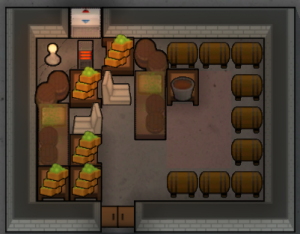Brewery
Brewery
A work station with all the equipment needed to mix wort for beer production. Wort must be fermented to finally become beer.
Base Stats
- Type
- Building – Production
- Mass
- 20 kg
- HP
- 180
- Flammability
- 100%
- Path Cost
- 50 (21%)
Building
- Size
- 3 × 1
- Minifiable
- True
- Placeable
- True
- Passability
- pass through only
- Cover Effectiveness
- 50%
- Terrain Affordance
- Medium
- Room Role
- Workshop
- Work Table not in Room Role Factor
- 80%
Creation
- Required Research
- Beer brewing
- Work To Make
- 2,000 ticks (33.33 secs)
The brewery is a production bench used by cooks to produce wort, a precursor to beer.
Acquisition[edit]
Breweries can be constructed once the Beer brewing research project has been completed. Each requires ![]() 120 Wood,
120 Wood, ![]() 30 Steel and 2,000 ticks (33.33 secs) of work modified by the construction speed of the builder.
30 Steel and 2,000 ticks (33.33 secs) of work modified by the construction speed of the builder.
Summary[edit]
The brewery is the second stage on the path to creating beer. After harvesting hops, pawns with the Cook work type enabled will take 25 hops to the brewery and make 5 wort. Wort will then be brought by haulers to a fermenting barrel where they will ferment and turn into beer.
Breweries are similar to stoves in that you add bills to the brewery, but the only option is "Make wort". Production speed is determined by the pawn's Drug Cooking Speed, itself largely controlled by their Cooking skill. Brewing has no quality, nor can beer cause food poisoning, so skill level has no other effect than speed.
Breweries have no other function other than making wort for producing beer.
| Name | Materials | Work to Make | Required Research | Type |
|---|---|---|---|---|
| 5× |
1,000 ticks (16.67 secs) | – | Crafted resources |
Analysis[edit]
Hops have a comparatively long rot time of 30 days, and so can be easily stored in stockpiles near to the brewery, rather than in a nearby fridge. This allows your cooks to spend more time at the brewery and less time walking to and from the stockpile.
For further efficiency, shelves can be used directly adjacent to the brewery's interaction spot to eliminate moving all together, so long as the shelves can be kept stocked by haulers. For more information, see the Shelf Analysis section.
The brewery is not associated with the kitchen room role. For the exact calculations, see the kitchen room role.

